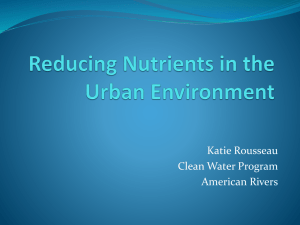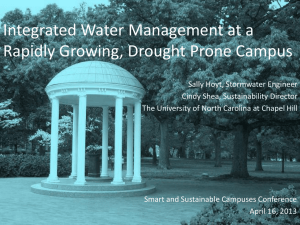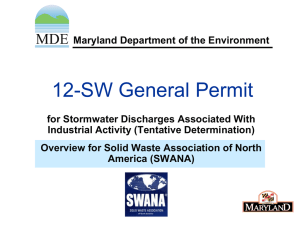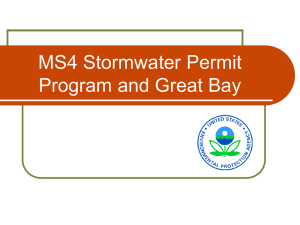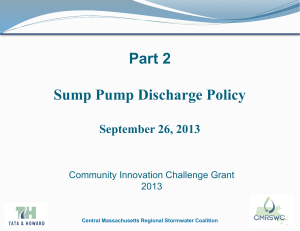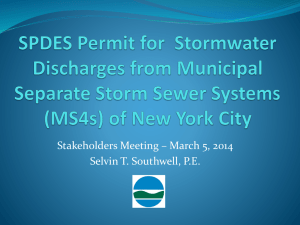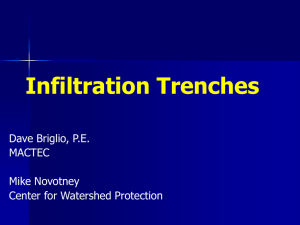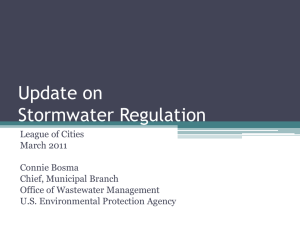City of Tacoma Stormwater Management Manual Updates Workshop
advertisement
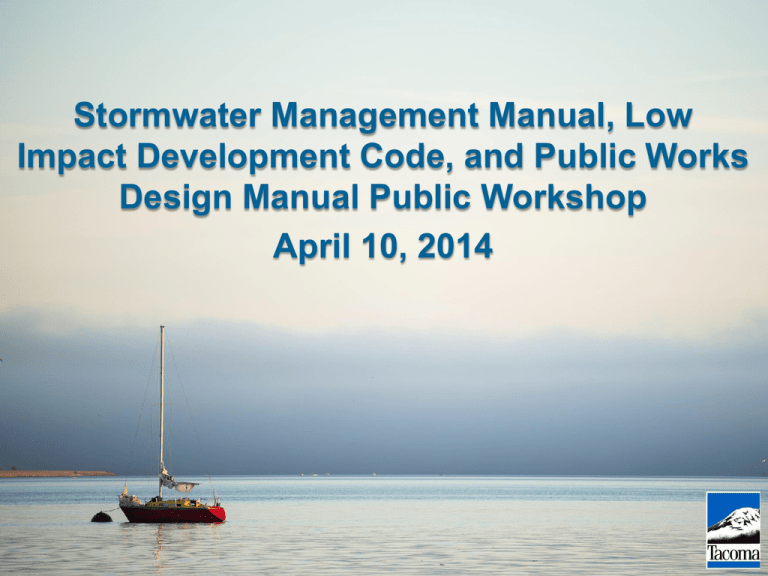
Stormwater Management Manual, Low Impact Development Code, and Public Works Design Manual Public Workshop April 10, 2014 City of Tacoma Stormwater Management Manual Updates Workshop Stormwater Management Manual – Why? • Phase I National Pollutant Discharge Elimination System (NPDES) Municipal Stormwater Permit (Permit) requires a program to prevent and control the impacts of runoff from new development, redevelopment, and construction activities. The City of Tacoma is electing to provide a Stormwater Management Manual equivalent to the Washington State Department of Ecology (Ecology’s) 2012 Surface Water Management Manual for Western Washington (2012 SWMMWW). Stormwater Management Manual History • October 1995 Manual • Developed in response to1995 NPDES Permit (Designed to be equivalent to Ecology’s 1992 Manual) • January 2003 Manual • Developed in response to extension of 1995 NPDES Permit (Designed to be equivalent to Ecology’s 2001 Manual) • September 2008 Manual • Developed in response to 2007-2012 NPDES Permit (Designed to be equivalent to Ecology’s 2005) • February 1, 2012 Manual – Current Manual • Developed in response to local community concerns and questions (developers, engineers, City staff). • Draft 2015 Manual – Currently in Development • Developing in response to 2013-2018 NPDES Permit (Designed to be equivalent to Ecology’s 2012 Manual) • Draft due to Ecology June 30, 2014 • Must be adopted by June 30, 2015 Changes to the Manual 1. 2. 3. Changes required to comply with 2013 NPDES Permit. Edits and reorganization for clarity. Changes to update City of Tacoma specific requirements – conveyance design and infrastructure protection. Volume 1 Changes Change – Minimum Requirements 2012 SWMM – 12 Minimum Requirements 1. Preparation of Stormwater Site Plans* 2. Construction Stormwater Pollution Prevention* 3. Source Control of Pollution* 4. Preservation of Natural Drainage Systems and Outfalls* 5. Onsite Stormwater Management* 6. Runoff Treatment* 7. Flow Control* 8. Wetlands Protection* 9. Basin/Watershed Planning 10. Operation and Maintenance* 11. Offsite Analysis and Mitigation 12. Financial Liability Proposed SWMM – 10 Minimum Requirements 1. Preparation of Stormwater Site Plans* 2. Construction Stormwater Pollution Prevention* 3. Source Control of Pollution* 4. Preservation of Natural Drainage Systems and Outfalls* 5. Onsite Stormwater Management* 6. Runoff Treatment* 7. Flow Control* 8. Wetlands Protection* 9. Operation and Maintenance* 10. Offsite Analysis and Mitigation *Denotes Ecology required Minimum Requirements Why only 9 Minimum Requirements? • Basin/Watershed Planning was removed for clarity. The applicant is not allowed to develop their own basin/watershed plan. This is a plan the City would develop and then the applicant would follow (for example the South Tacoma Groundwater Protection District). These specific basin requirements will be described in the SWMM text or as part of a separate policy document. • Financial Liability was removed because it was not used. Though financial liability is used in the work order process; its inclusion in the SWMM was confusing. The City will still require project cost information in order to determine which Minimum Requirements apply to a project but at this point, does not specifically bond for requirements of the SWMM. Exemptions – Pavement Maintenance • 2012 SWMM • Road Maintenance • Parking Lot Maintenance • Proposed SWMM • Combines road maintenance and parking lot maintenance into pavement maintenance. • Includes those practices that are considered redevelopment and describes when various surfaces are considered new hard surfaces and when they are considered replaced hard surfaces Why – Pavement Maintenance? • Ecology revised the exemption from road maintenance to pavement maintenance to ensure exemptions associated with roads would also be associated with other types of paving, such as parking lots. • The applicability to new and replaced hard surfaces was included in this section for clarity. The definition for new and replaced surfaces is also contained in the glossary. New Development (Permit Compliance Revision) • All new development shall be required to comply with Minimum Requirement #2 and #11. Minimum Requirements #10 and #12 #9 may apply to any project. • The following new development shall comply with Minimum Requirement #1 through #5, and Minimum requirement #10 (qualitative analysis only) for the new and replaced impervious hard surfaces and the land disturbed: • Creates or adds Results in 2,000 square feet, or greater, of new, replaced, or new plus replaced impervious hard surface area, or • Has land disturbing activity of 7,000 square feet or greater. • The following new development shall comply with Minimum Requirement #1 through #10 for the new and replaced impervious hard surfaces and converted pervious surfaces vegetation areas: • Creates or adds Results in 5,000 square feet or more greater of new plus replaced impervious hard surface area, or • Converts ¾ acres, or more, of native vegetation to lawn or landscaped areas, or • Converts 2.5 acres, or more, of native vegetation to pasture. Big Changes in New Development and Redevelopment Sections (Permit Compliance Revision) • Redevelopment has similar wording changes to new development. • All new development sites will be required to mitigate for both new and replaced hard surfaces regardless of monetary or space thresholds. (New development has less than 35% existing impervious surface coverage). • New Terms: • Hard Surface – An impervious surface, a permeable pavement, or a vegetated roof. • Vegetation – As related to applicability of the Minimum Requirements, vegetation shall mean native vegetation, pasture, scrub/shrub, uncultivated vegetation, or unmaintained non-native vegetation (e.g., Himalayan blackberries, scotch broom). Equivalent Areas 2012 SWMM • The City allows the Minimum Requirements to be applied to an equivalent area (flow and pollution characteristics) within the same site. For public road projects, the area must drain to the same receiving waters. Proposed SWMM • Minimum Requirements may be applied to an equivalent area that drains to the same receiving water. Minimum Requirement #1 (Permit Compliance Revision) • Stormwater Site Plans shall use site-appropriate development principles, as required by Tacoma Municipal Code, to retain native vegetation and minimize impervious surfaces to the extent feasible. • These site-appropriate development principles will be developed with the Low Impact Code update. Minimum Requirement #2 (Permit Compliance Revision) • There are now 13 elements of a SWPPP (previously there were 12). • Element #13: Protect BMPs – This Element intends to protect BMPs from sedimentation that occurs during construction; and includes protecting low impact development features from sedimentation and compaction. Minimum Requirement #5 (Permit Compliance Revision) • The requirement varies significantly based upon final discharge location. • Discharges to Non-Flow Control Exempt Waterbodies (Leach, Flett, Swan Creek, Joe’s Creek, other ditches and creeks) • Flow Control Exempt Waterbodies (Puget Sound, First Creek, Puyallup River) Hydrology Typically: Green – flow control exempt. Blue – Non-Flow Control Exempt 17 MR #5 – Not Flow Control Exempt • Projects triggering only MR#1-#5 and #10, shall either: • Use onsite stormwater management BMPs from List #1 OR • Demonstrate compliance with the LID Performance Standard. Rain Gardens cannot be used to achieve the standard but bioretention can. • Projects triggering MR #1-#10 shall either: • Use onsite stormwater management BMPs from List #2 OR • Demonstrate compliance with the LID Performance Standard. Rain Gardens cannot be used to achieve the standard but bioretention can. List #1 – MR #1-5 (Not Flow Control Exempt) • BMPs must be chosen in the listed order of preference: • Lawn and Landscaped Areas • Soil Quality and Depth (BMP L613) if feasible. • Roofs: 1. Full Dispersion or Downspout Infiltration 2. Rain Gardens or Bioretention 3. Downspout Dispersion 4. Perforated Stub-Outs 5. Collect and Convey • Other Hard Surfaces 1. Full Dispersion 2. Permeable Pavement or Rain Gardens or Bioretention 3. Sheet Flow Dispersion 4. Collect and Convey Rain Garden vs. Bioretention • Rain Garden - A non-engineered shallow landscaped depression for managing stormwater. Only used to meet intent of MR #5. • Bioretention – Engineered facilities that store and treat stormwater. Can be used to meet MR #6 and MR#7. Low Impact Development Performance Standard • Stormwater discharges shall match developed discharge durations to predeveloped durations for the range of predeveloped discharge rates from 8% of the 2-year peak flow to 50% of the 2-year peak flow. Refer the Minimum Requirement #7 for the predeveloped condition to be modeled. Projects that must also meet Minimum Requirements #7 must match flow durations between 8% of the 2-year through the full 50-year flow. • Addresses the lower, more frequent stormwater flows. LID Performance Standard List #2 – MR#1-10 (Not Flow Control Exempt) • BMPs must be chosen in the listed order of preference: • Lawn and Landscaped Areas • Soil Quality and Depth (BMP L613) if feasible. • Roofs: 1. Full Dispersion or Downspout Infiltration 2. Bioretention 3. Downspout Dispersion 4. Perforated Stub-Outs 5. Collect and Convey • Other Hard Surfaces 1. Full Dispersion 2. Permeable Pavement 3. Bioretention 4. Sheet Flow Dispersion 5. Collect and Convey MR #5 – Flow Control Exempt • There is no order of preference (applicants may use options from List #1 or List #2 or the LID Performance standard): • Lawn and Landscaped Areas • Soil Quality and Depth (BMP L613) if feasible. • Roofs: • Downspout Infiltration OR • Rain Gardens OR • Downspout Dispersion OR • Perforated Stub-Outs OR • Collect and Convey (only if infiltration, dispersion, and perforated stubouts are not feasible) • Other Hard Surfaces • Concentrated Flow Dispersion OR • Sheet Flow Dispersion OR • Rain Gardens Minimum Requirement #6 (Permit Compliance Revision) • Projects in which the total of effective pollution-generating impervious hard surface is 5,000 square feet or more in a threshold discharge area of the project. • The term effective is removed to ensure pollution generating permeable surfaces are included in the water quality thresholds. • Effective impervious surface are those impervious surfaces that are connected via sheet flow or discrete conveyances to a drainage system. (Effective impervious will apply to flow control). Minimum Requirement #7 (Permit Compliance Revision) • Projects in which the total of effective impervious surfaces is 10,000 square feet or more in a threshold discharge area, or • Projects that convert ¾ acres of more of native vegetation to lawn or landscape, or convert 2.5 acres or more of native vegetation to pasture in a threshold discharge area, and from which there is a surface discharge in natural or man-made conveyance systems from the site, or • Projects that through a combination of effective impervious surfaces and converted pervious surfaces hard surfaces and converted vegetation areas, cause a 0.15 cfs increase in the 100-year flow frequency from a threshold discharge area as estimated using the Western Washington Hydrology Model or other approved model (assuming a 15-minute time step). Comparison will be between existing and proposed conditions. Minimum Requirement #7 (COT Revisions) • 4 Types of Flow Control Standards Standard Requirement – Forested Condition 2. Standard Requirement – Existing Condition (new section) 3. Infrastructure Protection Requirement 4. Flow Control Exempt Waterbodies 1. MR #7 – Standard Requirement – Forested Condition • Applies in Leach Creek, Flett Creek, Joe’s Creek and discharges to gulches or creeks in Western Slopes and Northeast Tacoma Watersheds. • Same as previous manual: • Stormwater discharges shall match developed discharge rates from 50% of the 2-year peak flow up to the full 50-year peak flow. • The predeveloped condition to be matched shall be a forested land cover. MR #7 – Standard Requirement – Existing Condition • Applies to discharges to gulches or creeks in North Tacoma, Thea Foss, Tideflats, Lower Puyallup (except Puyallup River) Watersheds. • Stormwater discharges shall match developed discharge durations to existing condition durations for the range of predeveloped discharge rates from 50% of the 2-year flow up to the full 50-year peak flow. • The pre-developed condition to be matched is the existing land cover. Standard Requirement – Existing Conditions – Rationale • Permit states: The predeveloped conditions to be matched shall be forested land cover unless: The drainage area of the immediate stream and all subsequent downstream basins have had at least 40% total impervious surface since 1985. In this case, the predeveloped conditions to be matched shall be the existing land cover condition. • Ecology determined which areas can be considered 40% impervious since 1985. • A stream or channel will typically equalize in 10-20 years. It is believed that those streams that have existed in highly urbanized areas have adjusted to the existing land cover conditions so maintenance of those existing conditions should suffice to ensure no additional degradation. MR #7 – Flow Control Exempt Waterbodies – Puyallup River • If the following requirements are met, flow control is not required for projects that discharge directly or indirectly to the Puyallup River. If all any of the following requirements are not met, flow control per the Standard Requirement – Existing Condition in Section 3.4.7.3.2 is required and the quantitative analysis is not required. • Direct discharges to the exempt receiving water does not result in diversion of a stream. • Flow splitting devices are applies to route natural runoff volumes from the project site to any downstream Type 5 stream or category IV wetland. • The project site must discharge through a conveyance system comprised of manmade conveyance elements. • The conveyance system between the project site and the exempt receiving water shall have sufficient capacity to convey discharges from future build-out conditions of the site and the existing conditions from non-project areas. MR #11 (infrastructure protection) applies from the project to ¼ mile downstream from the site. MR #7 - Infrastructure Protection (COT Revision) The determination of when a downstream analysis is required and the type of analysis required is based upon the project scope as outlined below: a. For projects that do not add any impervious surfaces, a quantitative analysis of the downstream system is not required. b. For projects that add less than 10,000 square feet of impervious surface, the increase of stormwater discharges from the site shall not be more than 5% of the capacity in the downstream system. The analysis of the existing system shall be based upon the pipe with the lowest capacity within ¼ mile downstream from the discharge location or to a City-identified trunk main, whichever is less. If it is determined that the discharges from the site will be equal to or greater than 5% of the lowest capacity pipe, a quantitative analysis is required (see c. below). c. For projects that add 10,000 square feet or greater of impervious surface or that cause a 0.15 cfs increase in the 100-year, flow frequency from a threshold discharge area as estimated using WWHM (assuming a 15-minute time step), a quantitative downstream analysis per Minimum Requirement #10 shall be required to verify if the existing system has capacity. d. The applicant may resolve the downstream capacity problem or provide onsite infiltration or detention. Where infiltration or detention is provided, stormwater discharges for the developed condition shall not exceed the discharges under existing conditions. The applicant is not required to match flow durations but can match flow frequencies. If onsite detention or infiltration is proposed instead of upsizing the downstream system, the owner must provide a signed letter stating that they understand the proposal and accept the operation and maintenance of the onsite system. The City of Tacoma, Environmental Services is currently in the process of modeling the entire City of Tacoma system for capacity. If the project is located in a part of the City that has a developed capacity model, the applicant is not required to complete a downstream quantitative analysis. The applicant should contact the City of Tacoma - Site Development Group to determine if a capacity model has been developed. If the analysis shows a capacity concern within a ¼ mile downstream of the project site, the applicant can resolve the downstream capacity problem or provide onsite infiltration or detention (per c. above). The applicant may elect to provide their own model per Minimum Requirement #10 instead of utilizing the results of the City of Tacoma model. Minimum Requirement #8 – Wetlands Protection (Permit Compliance Revision) • Discharges to wetlands shall maintain the hydrologic conditions, hydrophytic vegetation, and substrate characteristics necessary to support existing and designated uses. • Projects shall comply with Guide Sheets #1 through #3 in Appendix D. The hydrologic analysis shall use the existing land cover unless otherwise directed. MR #8 – Guide Sheet #1 • Criteria that excludes wetlands from serving as a treatment or flow control BMP. • It is a category 1 wetland. • The wetland provides a high level of many functions (Category 1 and II wetlands) • The wetland provides habitat for threatened or endangered species. MR #8 – Guide Sheet #2 • Criteria for include wetlands as a treatment or flow control BMP. • It is a Category IV wetland or a Category III with a habitat score of 19 or • • • • less. There will be no net loss of function as result of the modification. There is no breeding population of any native amphibian species. The hydrologic function can be improved. The wetland lies in the natural routing of the runoff and the discharge follows the natural routing. MR #8 – Guide Sheet #3a • Protecting Functions and Values of Wetlands • Includes items such as maintaining buffers, retaining native vegetation, providing fencing, limiting access, and avoiding compaction. MR #8 – Guide Sheet 3b • Applies to full build-out conditions of the wetland’s watershed as well as full build-out conditions of the project. • Criterion 1: total volume of water into a wetland during a single precipitation event should not be more than 20% higher or lower than the pre-project volumes. • Criterion 2: total volume of water into a wetland on a monthly basis should not be more than 15% higher or lower than the pre-project volumes. MR# 9 – Operation and Maintenance • Basin/watershed planning was removed. (COT revision) • The operation and maintenance checklists were updated to include information from the Low Impact Development Operation and Maintenance Manual. MR#12 – Financial Liability • This section was removed. (COT Revision) Adjustments – New Section • Adjustments to the Minimum Requirements may be requested, in writing, to allow a reduction or modification of a requirement or to permit an alternative requirement. This applicant shall submit all requests to Environmental Services. Application for an adjustment to a Minimum Requirement shall be made in writing and include documentation that: • The adjustment provides substantially equivalent environmental protection. • Based on Sound Engineering Practices, the objectives of safety, function, environmental protection and facility maintenance are met. Appendices • Revised Stormwater Site Plan and Construction Stormwater Pollution Prevention Short Forms to make more user-friendly. • Updated O&M Checklists per SWMM and LID O&M Manual. Volume 2 – Stormwater Management for Construction Sites (Permit Compliance Revision) • 13 Elements instead of 12. Element #13 – Protect BMPs was • • • • added to ensure BMPs are protected from sedimentation caused by construction activities. This BMP also includes protecting LID features by ensuring heavy machinery is not used in these features. Stake and Wire Fence (BMP C104) is removed Vegetation Filtration (BMP C236) – new BMP. Small Project Construction Stormwater Pollution Prevention (BMP C180) was removed. Changes to BMP specifications were made throughout volume for consistency with Ecology manual. Volume 3 – Onsite Stormwater Management, Flow Control, and Conveyance • Rain Gardens were moved to Volume 6. • Perforated Stub-out BMP L604 was added. • Flow credits were updated in each section to match Ecology flow control guidance. WWHM modeling is required in most cases. • Flow credits are not applicable to sites just needing to meet MR #1-5, when MR#1-5 thresholds are met, MR#1-5 must be used on all applicable surfaces. • New Appendix to describe when a soils report is needed for each BMP and what is needed in that report. • Covenant and easement agreement for private facilities has been added to the manual. Volume 3 – Soils Reports • All projects using infiltration to meet MR #6, MR #7, or MR#8 must complete a site specific soils report. • All projects using infiltration to obtain flow credits must submit a site specific soils report. • In-situ testing to determine infiltration rates is required: • For determining infeasibility of a rain garden or permeable pavement. • For design of infiltration facilities to meet MR#6, MR#7, or MR#8 Vol. 3 – Design Saturated Hydraulic Conductivity (Permit Compliance Revision) 2012 SWMM Proposed SWMM • USDA Soil Textural • USDA Soil Textural Class Classification • ASTM Gradation Testing • In-Situ Infiltration Measurements • Soil Grain Size Analysis Method (D10, D60, D90) • Large Scale Pilot Infiltration Test (PIT) • Small Scale PIT • Drainage Area less than 1 acre • Testing for dispersed LID facilities • Soil Grain Size Analysis Method (D10, D60, D90) • Soils unconsolidated by glacial advance. Vol. 3 – Bypass and Offsite Inflow • Added guidance for bypass and offsite inflow. • Conditions for allowing bypass: • Runoff from the bypass area and the flow control facility converge within ¼ • • • • mile. The flow control facility is designed to compensate for the uncontrolled bypass area such that the net effect is the same with or without bypass. The 100-year peak discharge from the bypass will not exceed 0.4 cfs. Runoff from the bypass area will not create an adverse impact downstream. Water quality requirements are met. • Offsite inflow: • If the existing 100-year peak flow rate from any upstream offsite area is greater than 50% of the 100-year developed peak flow (undetained) then the runoff from the offsite area must not flow to the onsite flow control facility. Vol. 3 – Conveyance Design (COT revision) • Allow private onsite system design to be modeled at 10-year event rather than 25-year event. • For pipe systems, for the 100-year, 24-hour design storm, if overtopping of the system occurs, the applicant shall show the extent of the impacts on neighboring properties and the rightof-way. The applicant may be required to provide mitigation for localized flooding. Vol. 3 – Pipes and Structures (COT Revision) • CPEP pipe will no longer be allowed for pipes within the Public Right of Way. • In sag conditions, combination inlets (WSDOT Standard Plan B25.20-01) will be required. Volume 4 – Source Control BMPs (Permit Compliance Revision) • BMPs to consider for all commercial and industrial activities was expanded to include additional good housekeeping activities and ensure consistency amongst the NPDES permits. Volume 5 – Water Quality Treatment BMPs (Permit Compliance Revision) 2012 SWMM • Enhanced treatment is required for the following project sites that discharge to fish-bearing streams, lakes, or to waters or conveyance systems tributary to fishbearing streams or lakes: • Industrial Sites • Commercial Sites • Multi-Family Sites, and • High AADT Roads Proposed SWMM • Enhanced treatment is required for the following land use types that meet the requirements for stormwater treatment and: • Discharge stormwater directly or indirectly to fresh waters designated for aquatic life use or have an existing aquatic life use • Use infiltration strictly for flow control – not treatment – and the discharge is within ¼ mile of a fresh water designated for aquatic life use or that has an existing aquatic life use: • Industrial sites • Commercial Sites • Multi-family sites • High AADT roads Vol. 5 – Enhanced Treatment • Aquatic Life Use – Waterbodies as defined in WAC 173-201A- 600 and WAC 173-201A-602. • Categories include: • Char spawning and rearing. • Core summer salmonid habitat. • Salmonid spawning, rearing, and migration. • Salmonid rearing and migration only. • Non-anadromous interior redband trout. • Indigenous warm water species. • All surface waters of the state (fresh waters) not specifically named in WAC 173-201A-602 are to be protected. Volume 5 – Water Quality BMPs • Media Filter Drain (previously Ecology Embankment) added to manual as BMP for phosphorus treatment, enhanced treatment, and basic treatment. • Compost Amended Filter now called Compost Amended Vegetated Filter Strip (CAVFS). • Narrow Area Filter Strip no longer allowed as a treatment BMP Volume 6 – Low Impact Development • Rain Gardens moved from Volume 3 to Volume 6. • Rain garden, bioretention, and permeable pavement BMPs are associated with infeasibility criteria to determine when the BMPs are required for compliance with MR #5. Glossary • New terms or revisions to terms including: • Aquatic Life Use • Bituminous Surface Treatment • Chip Seal • City Block • Converted Vegetation Areas • Effective Impervious Surface • Hard Surface • Land Disturbing Activity • Landscaped Areas • Lawn Areas • New Development • New Hard Surface • New Impervious Surface • Pollution Generating Hard Surface – Now includes sports fields • Pollution Generating Impervious Surface • Project • Replaced hard surface • Vegetation Provide Comments – Please! • Via Email to swmupdates@cityoftacoma.org • Subject Line – 2015 SWMM Updates • Include Volume #, Section #, Page # • Include recommended changes when feasible. • All comments must be received by April 18, 2014. Contact Information Mieke Hoppin, PE 253.502.2105 mhoppin@cityoftacoma.org General Stormwater and Wastewater Questions stormandsewer@cityoftacoma.org 253.591.5218 Permit Intake Center – 3rd Floor TMB



